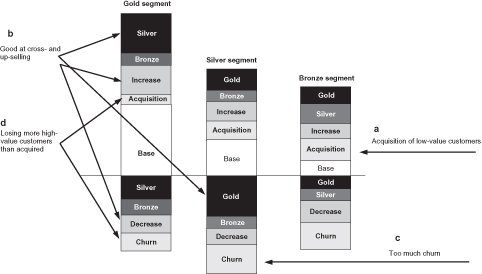LINK TO THE SEGMENT AND TURNOVER MOVEMENT MODEL
If in Chapter 2 you decided to the use the segment and turnover movement model as input for how you will select you future customer relationship management (CRM) activities, it would be a natural next step to measure the performance of these campaigns based on the same framework. To follow up on the example presented in Chapter 2, this would mean that if we set up the four suggested CRM activities, these all should be given individual success criteria and SMART objectives. Also we would expect to follow the overall success tracked via the segment and turnover movement model, since this is the framework that defined to us—via lead information—what we are trying to achieve. Therefore, we need lag information that can tell us whether we are achieving this overall objective or not (see Exhibit 7.3).
Exhibit 7.3 Analysis of the Segment and Turnover Movement Model

Get Business Analytics for Sales and Marketing Managers: How to Compete in the Information Age now with the O’Reilly learning platform.
O’Reilly members experience books, live events, courses curated by job role, and more from O’Reilly and nearly 200 top publishers.

